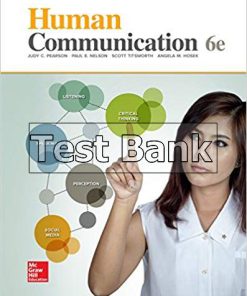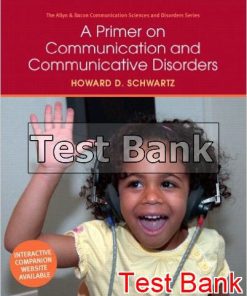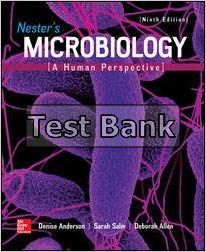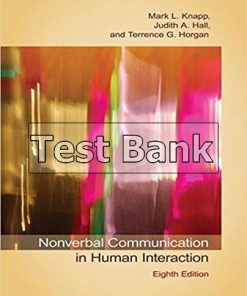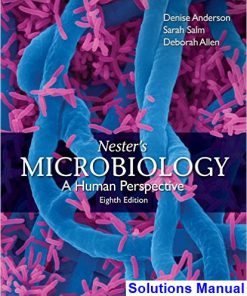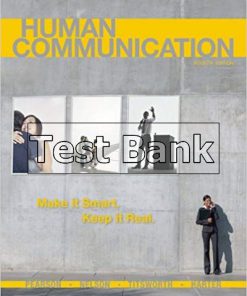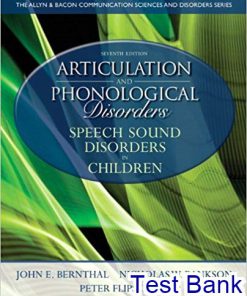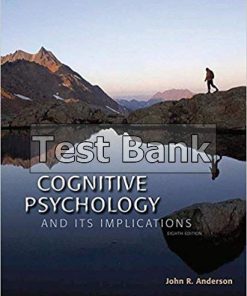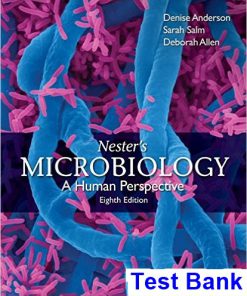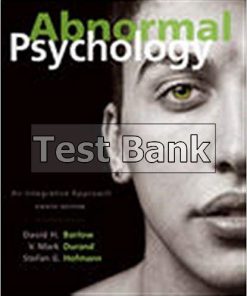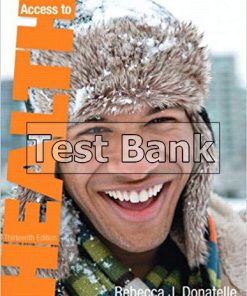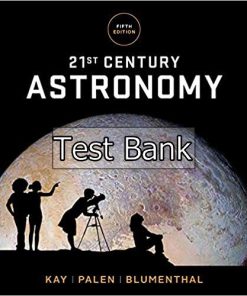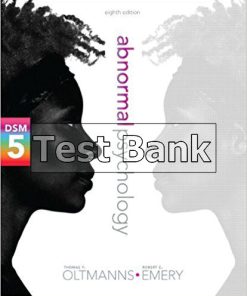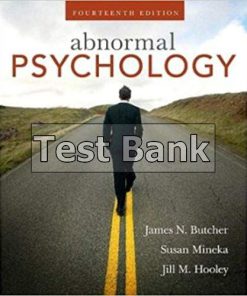Human Communication Disorders 8th Edition Anderson Test Bank
$50.00 Original price was: $50.00.$26.50Current price is: $26.50.
Human Communication Disorders 8th Edition Anderson Test Bank.
Human Communication Disorders 8th Edition Anderson Test Bank
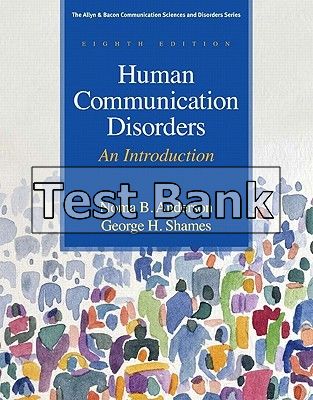
Product details:
- ISBN-10 : 0137061331
- ISBN-13 : 978-0137061334
- Author: Noma B. Anderson,George H. Shames
Updated with the most current research and information, the newly revised eighth edition of Human Communication Disorders continues to cover a broad range of topics including speech and language development, genetics, the biology and physics of communication, and an overview of cultural and linguistic diversity. With an emphasis on evidence-based practice, experts in speech-language pathology and audiology place communication processes and communication disorders in perspective, define basic theories of causation, introduce identifying characteristics, and present an overview of procedures for evaluation and treatment – while at the same time focusing on the real people who both have communication disorders and the real people who study them.
Table contents:
CHAPTER ONE
Introduction: Human Communication Disorders:
A Philosophy and Practice of Science in Service
Noma B. Anderson (Florida International University) and Shelly Chabon (Rockhurst University)
Personal Perspectives
Who Is Served?
What Services Are Provided?
Where Are Services Provided?
When Are Services Provided?
How Are Services Provided?
Service and Science: How? How Fast? How Often? How Much?
Why Serve?
Study Questions
PART ONE
Basic Communication Process
CHAPTER TWO
Development of Communication, Language, and Speech
Robert E. Owens, Jr (State University of New York, Geneseo)
Personal Perspective
Communication
Language
Speech
Summary
Study Questions
CHAPTER THREE
The Biology and Physics of Speech
Ray D. Kent (University of Wisconsin, Madison) and Houri K. Vorperian (University of Wisconsin, Madison)
Personal Perspectives
The Biology of Speech: The Anatomy and Physiology of Speech Production
The Physics of Speech: Speech Acoustics
Summary
Study Questions
CHAPTER FOUR
Multicultural and Multilingual Considerations
Kay T. Payne (Howard University)
Personal Perspective
Basic Concepts Related to Culture and Language
Varieties of American English
Language Differences and Communication Disorders
New Horizons in Multicultural/Multilingual Issues
Summary
Study Questions
Selected Readings
CHAPTER FIVE
Genetics: Basis for Development and Disorders
Lemmietta G. McNeilly (American Speech-Language-Hearing Association)
Personal Perspective
Case Study
Definition of Genetics versus Genomics
Inheritance Patterns
Genetic Testing
Genetic Counseling
Gene Therapy
Genomic Applications
Role of Genetics in Human Development
New Genetics
Human Genome
Human Genetic Variation and Health
Genetics and Communication Disorders
Social and Behavioral Research
Infusion of Genomics into Speech-Language Pathology
Ethical, Legal, and Cultural Implications
Summary
Case Study
Study Questions
Selected Readings
Websites of Interest
PART TWO
Disorders of Speech
CHAPTER SIX
Articulatory and Phonological Disorders
Richard G. Schwartz (The Graduate Center of the City University of New York) and Klara Marton (The Graduate Center of the City University of New York)
Personal Perspectives
Introduction
The nature of phonological disorders
Determinants of phonological disorders
Assessment
Intervention
Summary
Case Study
Study Questions
Selected Readings
Websites of Interest
CHAPTER SEVEN
Stuttering and Other Disorders of Fluency
Peter R. Ramig (University of Colorado at Boulder) and Ryan Pollard (University of Pittsburgh, Emeritus)
Personal Perspectives
Types, Descriptions, and Definitions of Various Disfluency Types
Theories of Causation
Normal Disfluency
The Development of Stuttering
The Assessment Process
Therapy for Stuttering
Prevention
Case Study
Some Final Thoughts by a Prodigy of Stuttering
Summary
Study Questions
Projects
Selected Readings
CHAPTER EIGHT
Voice Disorders
Christine Sapienza (University of Florida) , Douglas M. Hicks (Cleveland Clinic Foundation), and Bari Hoffmann Ruddy (University of Central Florida)
Personal Perspectives
Description of Voice Disorders
Assessment
Defining Pitch, Loudness, Voice Quality, and Resonance
General Classification of Voice Problems
Trauma and Surgical Modification
Examples of Vocal Fold Pathologies
Collecting and Assessing the Data about the Voice
Intervention for Voice Disorders
Speech without a Larynx
Case Study
Prevention
Study Questions
Selected Readings
Websites of Interest
CHAPTER NINE
Cleft Lip and Palate and other Craniofacial Disorders
Ann W. Kummer (University of Cincinnati Medical Center)
Personal Perspective
Case study
Structures of the lip and palate
Cleft lip and palate
Other craniofacial anomalies
Effect of clefts on feeding
Causes of speech disorders secondary to clefts
Normal velopharyngeal function and velopharyngeal dysfunction
Effect of clefts and velopharyngeal dysfunction on speech
Instrumental assessment
Treatment of speech disorders secondary to clefts
Importance of team care
Summary
Study questions
Selected readings and resources
CHAPTER TEN
Neurogenic Disorders of Speech in Children and Adults
Bruce E. Murdoch (The University of Queensland)
Personal Perspective
Definitions
Classification, Causes, and Characteristic Features of Neurogenic Speech Disorders
Assessment of Neurogenic Speech Disorders
Treatment of Acquired Neurogenic Speech Disorders
Treatment of Developmental Neurogenic Speech Disorders
Summary
Case Studies
Study Questions
Selected Readings
Websites of Interest
PART THREE
Disorders of Language
CHAPTER ELEVEN
Developmental Language Impairment during the Preschool Years
Catherine K. Bacon (Arizona State University) and M. Jeanne Wilcox (Arizona State University)
Personal Perspectives
Introduction: Developmental Language Impairment in Infancy and Early Childhood
Nature of Developmental Language Impairment
Factors Underlying Developmental Language Impairment
Identification of Developmental Language Impairment
Approaches to Providing Services To Young Children With Developmental Language Impairment
Summary
Case Studies
Study Questions
Selected Readings
Websites of Interest
CHAPTER TWELVE
Language Disabilities in School-Age Children and Youth
Barbara Culatta (Brigham Young University) and Elisabeth Wiig (Boston University)
Personal Perspectives
Introduction
Nature of School Language
Definition and Identification of Language Impairments
Types of Language Impairments
Assessment and Planning
Language and Literacy Intervention
Summary
Selected Readings
Websites of Interest
CHAPTER THIRTEEN
From Emergent Literacy to Literacy:
Development and Disorders
Froma P. Roth (University of Maryland)
Personal Perspective
Historical Perspective
The Essential Elements of Literacy
Relationship between Oral Language and Literacy
Extrinsic Factors Contributing to Emergent Literacy
Aspects of Emergent Literacy
Children at Risk for Literacy Problems
Prevention, Assessment, and Intervention Processes
Summary
Case Study
Study Questions
Selected Readings
Websites of Interest
CHAPTER FOURTEEN
Aphasia and Related Acquired Language Disorders
Audrey L. Holland (University of Arizona, Emerita)
Personal Perspective
Case Study
Aphasia and the Brain
Syndromes of Aphasia
Mechanisms of Aphasia
Bilingual and Multilingual Aphasia
The Person with Aphasia
The Natural Recovery Process in Aphasia
The Assisted Recovery Process in Aphasia
Related Disorders
Summary
Case Study
Study Questions
Selected Readings
Websites of Interest
DVD’s of Interest
CHAPTER FIFTEEN
Augmentative and Alternative Communication
Kathleen A. Kangas and Lyle L. Lloyd
Personal Perspectives
Potential Users of AAC
Categories of AAC
AAC Model
Reasons for AAC Success
Communicative Competence
Types of Impairments
Assessment
Intervention
Funding and Individual Rights
Outcomes Measurement and Evidence-Based Practice
Case Studies
Summary
Study Questions
Selected Readings
Websites of Interest
PART FOUR
Disorders of Swallowing
CHAPTER SIXTEEN
Swallowing: Process and Disorders
Barbara C. Sonies (University of Maryland and George Washington University)
Personal Perspective
Cultural Competence and Swallowing
Normal Swallowing
Neurology of the Swallow
Swallowing and Normal Aging
Abnormal Swallowing
Diagnosis
Signs and Symptoms
Instrumental Diagnostic Procedures
Evidence-Based Treatment
Compensatory Treatment Procedures
Case Study
PART FIVE
Disorders of Hearing
CHAPTER SEVENTEEN
Hearing and Hearing Disorders
Frederick N. Martin (The University of Texas at Austin) and Bart E. Noble (Austin VA Outpatient Clinic)
Personal Perspectives
Introduction The nature of sound
Disorders of hearing
Types of hearing loss
Implications of hearing loss
Summary
Case studies
Study questions
Selected readings
CHAPTER EIGHTEEN
Audiologic Rehabilitation
Alice E. Holmes (The University of Florida) and Shawna M. Dell
Personal Perspectives
Introduction
Amplification Devices
Counseling
Assistive Listening Devices
Therapy Approaches for the Hearing Impaired
Outcome Measures
Summary
Case Studies
Suggested Readings
Websites of Interest
Glossary
References
Author Index
Subject Index
People also search:
human communication disorders
human communication disorders an introduction
human communication in action 8th edition pdf free
human communication in action 8th edition pdf
human communication in action 8th edition




